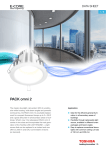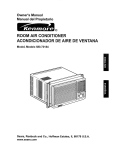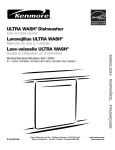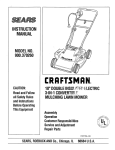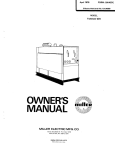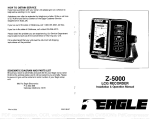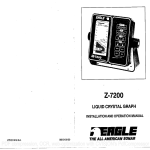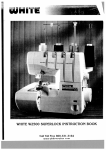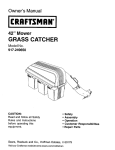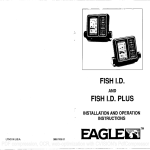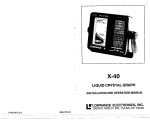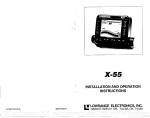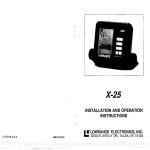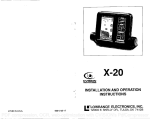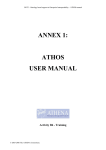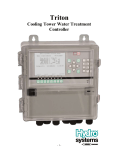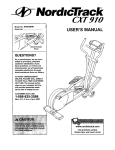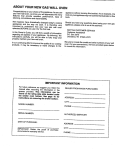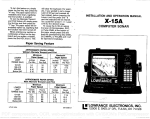Download Lowrance electronic X-3 User's Manual
Transcript
INSTALLATION AND OPERATION MANUAL X-3 COMMAND SUMMARY DIGITALOFF/ON DIGITALWs SIZE AUTORANGING OFF/ON• HIGH-SPEED Scroll ON/OFF CLEAR ENTRY CLEAR SCREEN FREEZE CHART RESTARTCHART DISCRIMINATION AUTO-RANGING W/ZOOM BO1TOMTRACK INCREASE SENSITIVITY DECREASE SENSITIVITY INCREASE CHART SPEED DECREASE CHART SPEED VIEW CHART SPEED WITHOUTCHANGING TURN OFF/ONAUTO SENSITIVITY TURN ON/OFF LIGHTS FEET-FATHOMS-METERS CHART ALARM SET DEPTH ALARMSET CLEAR ALARM TURN ALARM SPEAKER OFF/ON 2nd-5 2nd-2 2nd-B 2nd-4 2nd-O or 2nd-2nd LCG RECORDER 2nd-0-0 STOP/RESUME STOP/RESUME 0,1, or 2-DISC WINDOWSIZE-2nd-8 > PRESS KEY PRESS KEY PRESS FAST KEY PRESS SLOW KEY PRESS 2nd-FAST or SLOW < PRESS AUTO KEY 2nd-9 2nd-6 SELECT-SHALLOWSET or DEEP SETUP ARROW or DOWN ARROW TO ADJUSTDEPTH SELECT-SHALLOWALARM DEPTHSHALLOWSET-DEEPALARM DEPTH DEEP SET 2nd-O-SELECT NOTE KEY' • LOWRANCE ELECTRONICS, INC. 12000 E. SKELLY DR., TULSA, OKLA. 74128 988-0105-04 PDF compression, OCR, web-optimization with CVISION's PdfCompressor INDEX 2 3 4 Installation Power Connections BASIC OPERATION OFF/ON Sensitivity ChartSpeed Clear Range Auto Range Lower Limit Upper Limit ALARMS Chart Alarm Clearing Chart Alarm Depth Alarm Clearing Depth Alarm Light Discrimination ______ ______ Theeasiestway to do this is to press I 2ND I I 4 HISPO______J _______ 9 lithe sensitivityis too high, press 14 15 15 16 17 17 18 18 19 ADVANCED OPERATION High Speed Scroll FASTRAK Feet-Fathoms-Meters Auto Range with Zoom Bottom Track Auto Sensitivity Other Tips Transducers and Cone Angles Signal Interpretation Fish Signals Surface Clutter Water Temperature and Thermoclines Surveyinga Lake Bait Fish Troubleshooting Specifications Row to Obtain Service Schematic Diagramand Parts List SHALLOWWater Operation 1 In very shallow water, (less than eight feet)the LCG may operate better with the automatic and digital functions turned off. 5 7 8 o 8 " Digital SHALLOW WATER OPERATION Next, select a depth range. ( Selectingthe high speed scroll feature not only gives a high àhat speed, but also turns off the digital sonar,auto sensitivity, and auto ranging.If a slower chart speed is desired, press the 2nd key and then the 4 key again.Thiswill turn off the High SpeedScroll mode, howeverthe automatic sensitivity, auto ranging and digital function will remain off. The sensitivityis too high if the screen appearsblack, obscuring the bottom signal. 20 21 22 22 23 24 25 27 27 29 29 30 31 32 32 34 34 PDF compression, OCR, web-optimization with CVISION's PdfCompressor INTRODUCTION The LowranceX-3 Liquid CrystalGraph (LCG) is a compact unit that packs more power and featuresthan anyothersonar using a liquid crystal display (LCD.). The LCD. sets the X-3 apart from othersonar units. Insteadof a stylus writing on chart paper or a flashing neon light, the X-3 displays the depth information on a screen using small squares which turn black whenan echo is received. As each echo is detected,the signals move across the screen, leaving behind a record of the areathat was just passed. No othersonar has as many automatic features as the X-3. Onceturned on, it will find and display the bottom signal, fish, and other targets.As the depth of the bottom changes,the X-3 will automaticallychange the range, sensitivity, and other controls so thatthe bottom will always be displayed on the screen.If desired, the only key on the keyboardthat needs to be touched is the off/on key. However,the X-3 hasbuilt in override capability that allowsthe features to be used in any combinationto bestsuit local conditions. Range: 20 to 40 feet Discrimination: Level 1 High SpeedScroll: On Sloping Bottom, Large Fish from 22 to 34 feet Range: 5to 40 feet Large Fish on Bottom Fish at 19 feet Surface Clutter Extendsto 15 feet TheX-3 is nitrogenfilled and sealed for complete waterproof protection of the internalparts. The liquid crystal display and keyboard are backlighted for easy use atnight, and the X-3 is fully covered by a one year Lowrance full warrantywhichcovers all parts and labor for one year from date of purchase. INSTALLATION TheX-3 maybe installedin anyconvenient location, provided it can be tiltedfor the best viewing angle. Roles in the bracket base allow wood screw or thru boltmounting. Thebracket may be attached to aluminum panels with sheet metal screws, however,a piece of plywood may be required on the backof thinfiberglass panels to secure the mounting screws. Stainlesssteel is recommendedfor all mounting hardware. Make certain there is enough room behind the unitto attach the power and transducer cables. A Ye" holeis in the base of the gimbal bracket that allows the power and transducer cables to be routed straight down through the mounting surface. The smallest hole that will pass one connector thru is ¾". Thiswill allowthe transducerconnector and cable to be passed up through the hole and gimbal bracket,then the powercablewire can be pushed down thruthe bracketand dash. Afterthe cables have been routed, the hole may be filled with silicone rubber adhesive (RTV), or the bracket can be offset so that the majorityofthe holeis covered. PDF compression, OCR, web-optimization with CVISION's PdfCompressor 33 2 POWER CONNECTIONS Twelve volt DC power should be supplied by the boat's electrical system. Thepower cable may be attached to an accessoryor powerbuss, but if you have problemswith electrical interference(random dotsor lines that show whenever the boat's engine or other accessory is on), the cable should be attached directly to the battery. HOW TO OBTAINSERVICE If you have a problemwith your sonar unit, please give us a chance to help before sending it in for repair. Assistancecan often be extended bytelephone or letter. Write or call one of our AuthorizedService Centersor the LowranceCustomerService Department in Tulsa,OK. If you live out of the state of Oklahoma,call 1-800-331-3889,toIl free. If you live in the state of Oklahoma, call collect 918-437-6881. Pleasedetail the problemyou are experiencing.Our Service Department may be able to save you the inconvenienceof returning your unit. Ground Neqalive) If it is determinedthatyour unitmust be returned,full shipping instructionswill be provided. Figure 1 The power cable hastwo wires, red for the positivelead and black is ground or negative.An in-line fuse holdercontaininga 3 amp fuse is supplied with the X-3. Thisshould be attached to the red wire on the power cable with the crimp connector.Theother end of the fuseholder should be attached to the battery or accessory buss.If the cable is not long enough, splice ordinary #18 lamp cord to reach.Just be certain that the fuse holderis as close to the power source (batteryor accessory buss) as possible. This will protect the power cable and unitin the event of a short TheX-3 is protected from accidental polarity reversalsand will not be harmed if the wires are reversed. (However, the unit will not work until the proper polarity is applied.) SCHEMATICDIAGRAM AND PARTS LIST Shouldyou desire a schematic and parts list for your Lowrance sonar, send $1.00 to the address below and it will be mailed to you promptly. Pleasebe sure and give us the model and serial numberofyour Lowrance sonar unit Mail To: Lowrance Electronics 12000 E. Skelly Dr. Tulsa, Oklahoma 74128 Electrical noise picked up by the power cable can be minimizedby routing it away from otherpossible sources ofelectrical interference.One of the largest noise generators is the engine'swiring harnessthat runs from the engine to the boat's instrumentpanel. This harness usually contains a wire for the tachometer which radiates RF (radio frequency)energy. For the bestresults,keep the power and transducer cables away from the engine wiring. Bilge pumps are also noisy, so try to keep the X-3's cables away from them,too. VHF radio antenna's coax cable radiate RF energy at higherpower levels than even the engines wiring hamess.It isvery importantto keep the X-3'spowerand transducer cables as far away as possiblefrom the VHF radio's antennacable. 3 32 PDF compression, OCR, web-optimization with CVISION's PdfCompressor SPECIFICATIONS Dimensions 5¾"H x 8°/16"Wx 2%"D Weight 1¾ pounds Transmitter 192 kHz OutputPower 600 watts peak to peak typical 75 watts RMS 90 db ReceiverSensitivity > Operating Current 200 ma (lights off) 500 ma (lights on) Operating Voltage 9-15 vdc Number of pixels 82 x 32 2624Total Depth Capability 300'-500' typical (with 20 degree transducer) 500'-700'typical (with 8 degree transducer) DisplayScroll Speed .5" per minute (minimum, normal mode) 8" per minute (maximum, normal mode) 32" per minute (Nigh SpeedScroll) Temperature (operating) Temperature (storage) 0 degrees C to +60 degrees C +32 degrees F to 140 degrees F —40 degreesC to +80 degrees C —40 degrees F to +176 degrees F BASIC OPERATION When first turned on, the X-3 automaticallyadjusts the sensitivity, range, and chart speed according to water and bottom conditions. In fact, it can be leftin this mode and itwill track the bottom and display it atall times, automaticallychanging the range as the bottom depth varies. The sensitivity will also change as required, to keep the bottom signal displayed.If present,fish or other targets may be seen. At first, operate the X-3 in the automatic mode only.Just turn it on and watch it work. Then, read the following chapter on the X-3'sbasic operation and learn how to adjust it for your specific needs. Later, read the Advanced Operation section to make the most out of the X-3's remarkablecapabilities. OFF/ON The off/on key is in the lowerright hand cornerof the keyboard.It was placed in this location so that it would be easy to find—even at night. Turning poweron To turn the X-3 on, press the off/on key. (Note: the unitwill beep every time a key is pressed.This is how theX-3 signals that an entry on the keyboard hasbeen made.) The chart lights will begin flashing,then turn themselvesoff aftersix seconds.A message (see figure 4) will be displayed and the number"0" will flash. This number is the digital bottom depth display.Afterthe unithas found the bottom, the depth will be shown in the display,proper sensitivityand range will be selected,and return echoes from the bottom,fish, or othertargets will begin scrolling across the display Turning power off To turn the X-3 off, press and HOLD the off/on key until the display is erased. This maytakeseveralseconds. Theunitwill beep continuously until ypy releasethe off/on key. Remember, you must holdthe Off/On key down until the screen.is erased. If you don't holdit for several seconds, the unit won'tturn off. 4 PDF compression, OCR, web-optimization with CVISION's PdfCompressor 31 TROUBLESHOOTING SENSITM If the unitworks properlywhen stopped or at low speeds,but loses the bottom signal at high speed,the transducer couldbe improperly installed. Readthe transducer installationmanualfor the correct mounting liii BAR procedure. If the transducer is installed properly,then electrical interferencecould be the cause. Double check the installation, particularlythe power and transducer cable routing. Make certain thatthey are away from the enginewiring or other wiring harnesses,especiallythe tachometer wiring. II :E;E A F: c H Figure 2 •'i1F9i1'1bth' AUTO j'tU' SENSITIVITY When firstturned on, the X-3 is in the AUTOSEARCH mode. This means the sensitivityand range are being automaticallyadjusted by the microcomputer to find and lock onto the bottom. Thesensitivity can be leftin the automatic mode,or it can be manually adjusted higher or lowerto suit conditions. The sensitivitylevel settings are displayed by a horizontal bar at the top of the display.See Figure 2. When the sensitivityis at minimum,the bar is very short As sensitivityis increased,the bar will travel to the right increasing in length correspondingwith the higher sensitivityselling. When the sensitivity is set to maximum, the bar will run completely across the top of the display from left to right Should the display "freeze' check to see if the top line ofthe display or the digital bottom depth is flashing. If it is, then the unit is working, but the digital has lost the bottom signal, and it is trying to find it The chart stops scrolling when the digital loses the bottom. It will start moving again when the digital regains the bottom. If neither the top line of the display nor the digital bottom depth is flashing and the chart won'tscroll,then turn the unit off and backon again. Theunitshould begin working normally. If it cannot find the bottom signal, and youare in shallow water,(less than eight feet)following the directions on page 24 concerningshallow water operation may help. Ifthe unit doesn't turnon when the ON/OFF key is pressed, then check the fuse or battery conections for tightnessor corrosion. Fish signals, especiallyin shallow water,do not alwaysarch, but appear as irregularlyshaped marks. Fish arches are most likelyseen in 40 feet or deeper water, using a zoom range (for example40 to 60 feet).Read the section "Fish Signals" on page 25. If the unit will not turn off, rememberthatyou should press and HOLDthe ON/OFF key down until the display goes blank. If you don't hold the key down, the unitwon'tturn off: On rare occasions and in certain installations,electrical interference could cause the LCG to display random informationon the screen or the keyboard may not function properly. (For example, pressingthe ON/OFF key will not turn the unitoft). To restore itto working order, firsttry pressing2nd-O-0. This should clearthe screen.If this doesn't work, simply unplugthe power cable from the back of the unit plug it backin, and turn it on. TheAUTO key at the top middle position on the keyboardtUrnsauto sensitivityoff and on. Press it once, and autO sensitivityis turned off. Press it again, and auto sensitMty will be turned ott The auto annunciator is below the sensitivitybar, and canbe seen when the auto sensitivityis on. 5 30 PDF compression, OCR, web-optimization with CVISION's PdfCompressor SURVEYING A LAKE Themost successfulanglers on any lake or reservoirare those who fish it dayafter dayand year afteryear until theylearn the hot spots that pro- duce fish consistently.They discover through experiencewhere, and at whatdepth, they canexpect to find the kind of fish they wantat any season.And they realizethat these productiveareas change throughout the year dependingon water level,temperature,food, and other factors. With the aid of the X-3, anyone can eliminateguesswork and concentrateon the areas where fish are likely to be—even if its thefirsttime on the lakel The most efficientway to become acquaintedwith a body of water is to survey it with your X-3. Start out with a map of the lake, if possible and indicate the promisingspots in relation to landmarks on shore. Asyougo about your survey, yourX-3 will tell youthe depth and kind of bottom, It will also reveal fish, perhaps schools of crappies or white bass suspendedover deep water, If multiple signals on the display indicate a good school, it is worth itto stop and fish for them.You may not get any farther. Keep a few Lowrance Fish-N-Floats in the boat, ready to toss overboard. When the X-3 indicatesa school of fish, throwthe buoy out. Thestring will unwind until the sinker hits bottom.Then, because of the marker'sflat shape, it won'tunwind any farther With the school thusmarked,you can make yourturn and come back to fish in exactly the right spot. Thisis essential when you're far from shore on a big lake. Unless you mark the school of fish when you're over it, you may not be ableto find it again. BAIT FISH The importanceof baitfish to successful fishing can'tbe overemphasized. They are the principle food ofgame fish in most waters. Baitfish are the planktonfeeding forage fish, such as minnows and shad. They can also be the young of game fish, suchas crappies, bluegill, and white bass whichalso feed near the surface. Most baitfish are concentratedwithin five feet of the surface where sunlight promotes the growth of the plankton on whichtheyfeed. One method of fishing is to usethe X-3 to findthe bait fish first. Usually, game fish will be nearby—oftendirectly beneath the school of bait fish at 12 to 15 feet deep. iiiuii AUTO - ANNuNCIATOR WIiCi.E IIIIIIIHIIIIUhIIHhII AUTO. J !I!fli!F \SURFACE, CLUTTER FISH WEAK BO1TOM— I SIGNAL Bo RANGE 0-96 FEET — 96 Figure 3 AUTO. RANGING 96 - STRONG BOTTOM SIGNAL AUTO. RANGING Figure4 To manually adjust the sensitivity, press the AUTO key. TheAUTO annunciatorwill disappear.To increasethe sensitivity, press and hold the right arrow key> until the sensitivityis at the desired level.The leftarrow decreases sensitivityin the same manner. Notice how the sensitivitybar moves as you changesettings. When you press the right arrow key, the bar moves to the right showing an increase in sensitivity. Pressingthe left arrow key moves the bar tothe left, showing a decrease in sensitivity. You can also seethe changeson the display.Figure 3 shows a graph with too little sensitivity, whileon the right the sensitivityis adjusted properly. Note how the surface signal is very small, and the bottom signal is also narrow on the left chart.Onthe right, the sensitivityis adjusted properly; a fish is now visible, the surface clutter is more pronounced, and the bottom signal has widened. For more information on graph records, see the section called Graph Interpretation. < When the horizontal bar reaches the far right hand side ofthe screen, the sensitivitylevel is at the maximumlevel. When high sensitivitysettings are used, a second bottom echo may appear Thisis normal and is caused by the returning signal reflectingoff the surface of the water, maka second trip to the bottom and back. To turn Auto Sensitivityback on, press the AUTO key. Remember, the automatic sensitivitycontrol can be turned off or on at anytime by using the AUTO key. See Page 22 for more auto sensitivityfeatures. 6 PDF compression,29 OCR, web-optimization with CVISION's PdfCompressor SLOW LCHARTp STOP I RESUME FAST A knowledge ofthe water temperaturesvarious fish prefer, and in which 1 CHART SPEED When theX-3 is firstturned on, the chartspeed runs at a pre-determined speed. If a higherspeed is desired, press and hold the FAST key in the chart section of thekeyboard until it runs at the desired speed.To slow the display,press and hold the SLOWkey. Whenever either of these keys are pressed, the sensitivitybar at the top of the display will changeto a dashed line. This now representsthe chart speed. Ifyou press and hold the FAST key, foräxample, the bar will start moving to the right, signifying that the chart speed is increasing.There are thirty two steps of chart speed. By holding either the FAST or SLOW keys, the display can be speeded up or slowed down. When the horizontal barreachesthe far right side of the screen,the chart speed is at its maximum value. TheX-3 will "chirp" signifyingthat the maximumchart speed has been reached. CHART SPEED BAR -,- they usually remain, helps you get the most from your X-3. Tofind the different temperatures,a surface temperaturemeter, such as the LDT-3000 is a valuableaid to your fishing.This unit provides an extremelyquick responseto identifyingthe desired surface water temperaturesfor various species. The temperatureof water in the lake is seldom constantfrom top to bottom. Layersof differenttemperaturesform,and the junction of a warm and cool layer of water is called a thermocline.The depth and thickness ofthe thermocline can vary with the season or time of day. In deep lakes there may be two or more at differentdepths.Thermoclines are important to fishermen becausetheyare areas where fish are active. Many times bait fish will be abovethe thermocline whilelarger game fish will suspend in or just above it TheX-3 can detect this invisible temperaturelayer in the water, but the sensitivitywill probably have to be turned up to see it uuuo flUID 111111111 jj Figure 5 "WI AUTO. At times it is desirable to stop or "freeze"the display to examinean echo. 111—---- Pressingthe STOP/RESUMEkey once wil freeze the display.While the display is stopped, theverytop of the surface line will flash on and off to signify that the unitis in the freeze mode. PressingSTOP/RESUMEagain will start the display moving at the last chart speed setting. —THERMOCLINE [2ND] 2ND KEY TheX-3 has many different functions,but only a limited amount of space for keys. Therefore,some of the keys have morethan one function.The key's primary function is printed very large, whilethe secondary function is printed underneathwith small letters of a different color. The key in the middle of the bottom row labeled2nd must be used to access the = Figure 24 4.A rn Ut' : secondary functions of the keys. For example, the 9 key hasa small label beneaththe number nine that says "LIGHT". If you press the 9 key by itself, the X-3 thinks that you want the number 9. However,ifyou press the 2nd key first, then press the nine key, the X-3 will turn on the lights in the display.The2nd key just reassigned the meaning of the 9 key from a 9 to LIGHT 28 PDF compression,7 OCR, web-optimization with CVISION's PdfCompressor SURFACECLUTTER Themarkings at the top of the screen representthe surface of the water which can extend manyfeet below the surface.This can interferewith fish signals or other targets. It's called Surface Clutter and is caused by algae, plankton, air bubblescaused by wave action or boat wakes, bait fish, or temperatureinversions. These marks are normal and can be seen at any timeduring the year.It's usually the worst in the spring and summer,slacking off in the fall and winter. 101 I CLEJ CLEAR Ifyoupress a key that is not whatyouwanted, you canwait six seconds before pressing another key and the X-3 will automatically clear or "forget"the last key entered. For example,if. you wish to turn on the lights,the proper keys to press are 2nd-9. However, if you accidentally pressed the 0 key instead of the 2nd key by accident,you could wait six seconds until the 0 disappears from the screen, then press 2nd-9.Another quick wayto clearan incorrect entry is to press 2nd-O and the last key enteredwill be erased. The entire display maybe erased by pressing 2nd-0-O. Everything except the digital numbers(if turned on) will be cleared fromthe display. SURFACE cLurrER RANGE F Figure 23 Although the X-3 will automaticallychange the range whenever the bottom getsshallower or goes deeper,thereare times when it is desirable to expand the range, or look at a differentsegment ofthewater below. Therange can be setanywherefrom 0 to 989 feeton the upper limit and 10 to 999 feet on the lower limit, provided the lower limit is no closerto the upper limit than 10 feet. WATER TEMPERATURE AND THERMOCLINES Water temperaturehas an important—if not controlling—influence upon the activitiesof all fish. Fish are cold blooded and their bodies are near the temperatureof the surroundingwater. During the winter, this slows down their metabolism so that they can only utilize about a fourth as much food as they consume in the summer. Most fish don't spawn unlessthe water temperatureis within rather narrow limits. Trout can't survivein streams that get too warm; bass and other fish eventually die out when stocked in lakes that remain too cold during the summer. So fish will do without food rather than venture into waterthat is too hot or too cold; others will shift position for a temperature change as slight as one-half of one degree. While some fish havea wider temperaturetolerance than others, each of them has a certain range within which it tries to stay. Schooling fish suspended over deep waterlie at the level that providesthis temperaturein which, we assume, theyare the most comfortable. 18 tAUTO RNG AUTO RANGE When the X-3 is firstturned on, the AUTO RANGE function is enabled. It may be turned off anytimeby pressingthe 2nd key, then the 8 key. (In this manual, pressingkeys in sequence as just described will be shown like this: 2nd-B.) TheAUTO RANGING annunciator in the bottom right hand corner ofthe displaywill disappear,signifying the automatic ranging capability hasbeen tumed off. To return to the AUTO RANGE mode,simply press the 2nd-8 keys again and the unit will automaticallytrackthe bottom and place it in the lower 4/5 of the screen. 8 27 OCR, web-optimization with CVISION's PDF compression, PdfCompressor SCALE There are ten scale markers printed on both sides of the X-3's display to help determine whatthe depth of a target is. For example, if the depth range is 0 to 60 feet, then each mark is equal to six feet. If the target (such as a fish) was next to the 5th line, then it is 30 feet deep (5 lines times six feet=30feet). To make it easier to use the depth scale, use ranges in multiples often, i.e. 10, 30, 140, etc. c:: •iui SENSITIVITY/CHAR Very small fish probably will not arch at all, while medium sized fish will show a partial arch, or a shape similar to an arch, if they're in deep water Large fish will arch, but the sensitivfty must be turned up, especially in deeper water There will be times when the sensitivitycannot be turned high enough to get fish arches becauseof the heavy surface clutter, therrnoclines,etc. 12 — 24 SCALE MARKERS One of the best ways to get fish arches is to expand or "zoom" a segment of the water, for example40 to 60 feet. Thesmaller the segment the better the screen resolution will be.Then, turn up the sensitivityas high as possible without getting too much noise on the screen.In medium to deep water,this method should workto displayfish arches. 1llmm36 48 LILI LOWER LIMIT Thedepth of the water will affect the size and shape of the fish arch due to the coneangle diameter. For example, if the cone passesover a fish in shallow water,the signal displayedon the X-3 may not arch at all, due to the narrow conediameter and the resolutionlimitations of the display. Comparedto a paper graph, the X-3 cannot show as finedetail because the pixels (dots on the screen) are much larger than a paper graph's. Therefore,the X-3 cannot show fish arches as wellas a graph. Ii.--.—— — Remember, there must be some movementbetween the boat and the fish to developthe arch. Usuallythis means trolling at very slow speeds with the main engine in gearat a minimum throttle setting. Figure 6 AUTO. RANUING ——"OHIO F LOW1 LIMIT J To change the lower limit, press the lower limit desired from 10 feetto 999 feet and then press the LOWER LIMIT key. Thedisplay will immediately change to the new depth range and display the new lowerlimit at the bottom ofthe screen. The lower limit may be changed anytime, even if the AUTO RANGE function is on. However,if a lower limit is selected that is less than the depth ofthe bottom whilethe unitis in the AUTORANGE mode, it won'taccept the entry For example, supposethe X-3 is in the AUTO RANGE, mode and the lower limit is 75 feet with the bottom at 60 feet If a new lower limit of 55 feetwereentered on the keyboard, the X-3 would chirp, and keep the lowerlimitsetting of 75 feet. P1 Figure 22 26 PDF compression,9 OCR, web-optimization with CVISION's PdfCompressor For example, to set the range from 0 to 31 feet, press 3-1 -LOWER LIMIT. FISH SIGNALS The signals displayedon the X-3 by fish can be identified by various shaped markings in certain patterns,as opposed to random marks created by noise, or the solid, continuous markings made by the bottom. Individualfish can,attimes, be distinguished by a characteristicarch that separatesthem from their stationarysurroundings.The reason for this is shown below. The distanceto a fish when it moves intoa sonar's cone of sound is shown as "A" Figure 21. When the fish has moved into the center of the cone, the distance to it will be shorter,"B" and as it moves out of the cone, the distancewill increase again as shown in "C". If a partial arch occurs mostof the time on your unit(the mark curves up, but not back down, or vice-versa)it could be the transducer is not pointed straight down. If the transducer is mounted on the transom, adjust it until the fish show the distinctive arch. Thismay take some trial and erroruntil the correct mountingangle is achieved. .p Figure7 LIMIT LOWER I'll" NOTE: Although the maximumlower limit of the X-3 is 999 feet, the actual depth that the X-3 will reach is dependenton the water conditions, bottom conditions,and the quality of the transducer installation. I AP\c —III Figure 21 0 UPPER LIMIT UPPER LIMIT It is often desirable to expanda section ofthedisplay to show more detail. This is made possible on the X-3 by using the UPPERLIMIT key. To change the upper limit of the screen,simply press the desired depth (any numberbetween0 and 989 feet) and then the UPPERLIMIT key. The only restriction on the upper limit is that it must not be closerto the lower limit than 10 feet. In other words, if the lower limit is setto 81 feet, the upper limit cannot be set any closer than 71 feet A ten foot segment or larger (20, 30, 120, etc.) is required. Upper and lower limits may be set in various combinationsto show segments from the surfaceto the bottom and nearly anywhere in betweento expand or "zoom" a portion of the display.If a ten foot segment is chosen, then the screen resolution is 1½". This meansthat each dot is equal to 1½ incheswhena ten foot segment is chosen. 10 PDF compression, OCR, web-optimization with CVISION's PdfCompressor 25 Example: Set range to 16 to 31 feet Press: 1-6-UPPER LIMIT then 3-1 LOWER LIMIt UPPER LIMIT The20 degree transducer is almost always the best to use in fresh water, while the 8 degree is used mostly in salt water In a deep water environment, (300 feet—freshwater, 100 feet—salt water) the narrow coneangle is more desirable because it can penetrateto much deeper depths since the sound energy is concentrated in a smallerarea. Both the 8 degree and the 20 degree transducersgive accurate bottom readings,even though the bottom signal is much wideron the 20 degree model because you are seeing more ofthe bottom.Remember, the shallow edge ofthe signal shows you the truedepth.The rest of the signal tells youwhetheryou are over rocks, mud, dropoffs, etc. Saltwater boats need to have the transducerpaintedwith a thin coatof anti-foulant paint to prevent organismsfrom growing.If unchecked,barnacles and othermarine growth will cause a decrease in the transducer's sensitivity. Do not use a metal based anti-foulantpaint as it will decrease the transducer's sensitivityalso. There are special anti-foulant paints carriedby most marine dealers specificallydesigned for transducers. Figure 8 NOTE: When the X-3 is in the AUTO RANGE mode, the upper limit may be changed at anytime. If the upper limit is changed while the unitis in theAUTO RANGE mode,the X-3 will continueto select a lowerlimit that will keep the bottom displayed in the lower ¾ portion of the screen. 15 (PtGrTAL DIGITAL A complete digital sonar is incorporated intothe X-3. It automaticallydis- criminates betweenthe valid bottom echoes and false echoes from fish, thermocline, or surface clutter Thedigital displaywill show only the bottom depth. It may be used at anytime, in conjunction with anyother mode theX-3 may be in (with the exception of FASTRACK or High Speed Scroll modes described in the AdvancedOperation section of this manual). When the X-3 is turned on, the bottom depth will be displayed on the screen. 11 SIGNAL INTERPRETATION Becauseyour X-3 is both extremelysensitiveand powerful, it cangive youan accurate picture of the kind ofbottom over whichyour boat is passing. A bottom offirm sand, gravel, shell, or hard clay returns a fairly wide signal. If the automatic sensitMty is turned off, and the signal narrows down, then it means thatyou have moved over a mud bottom. Mud absorbs the sound waves and returns a weak signal. Turn up the sensitivity. If you have the automatic sensitivityturned on, watch the sensitivity bar. As the boat passes over the mud bottom,the X-3 will automaticallyincrease the sensitivityto maintaina good bottom signal. The sensitivitybar will help you in determiningifthe bottom is softor hard. If it increaseswhile in the same depth of water,then the boat has moved over a soft bottom.If it decreases,then it is over a hard bottom.Of course,as the water depth increasesor decreases,the sensitivitywill change, also. Big rocks or stumpson a smooth bottom send back signals above the bottom, the distance depending upon their height If you watch as you approach a post or a tree stump, it will be clealry visableas a short line extendingabove the bottom signal. PDF compression, OCR, web-optimization with CVISION's PdfCompressor 24 TRANSDUCERS AND CONE ANGLE Thesound waves from the transducr go down ihtothe water in a cone shaped beam, much like the beam frOm a flashlight Theangle betWeen the outside edges ofthe cone is called the cone angle. Lowrance offersa choice of transducers with either an 8 or 20 degree cone angle that will interchangewith any!of the 192 kHz sonar products. In otherwords, any Lowrance sonar instrumentcan be used with any Lowrance transducer of the same frequencywithoutretuning of any kind, and no loss of performance.However, the use of any other manufacturers' transducerwill result in a loss of performance. Generally, wide coneangle transducers (20 degrees) are ideally suited BOTTOM for operatingin shallow to mediumwaterdepths.The20 degree cone angle allows youto see more of the underwaterworld.In 15 feet of water the 20 degree cone covers an area that's about six feet across. The8 degree transducercovers only about a two foot circle. DEP11-l Figure 9 For easier reading,the size ofthe digital numbers can be doubled by pressing2nd-2.To return them backto the smaller size, press 2nd-2 again.The numbersmust be displayed on the screen before you press 2nd-2. Cone Angle §:- 50' Depth Diameter _________ 50 7ft. iumIIIHhi 18ft. boo 14 21 35•• liso 200 28 71• 53 100' 150' Figure 20 F: 200' Li Figure 10 8°at3db PDF compression, OCR, web-optimization with CVISION's PdfCompressor 23 ! 12 To turnthe digital displayoff, or back on again, press 2nd-5. NOTE Even if the digital numbersare not being displayedon the screen,the digital sonar will still continueto function.If the digital loses the bottom signal,the chart display will stop until the digital finds the bottom. If the digital numbersare being displayed on the screen,the chart display will stop, but the digital will flash the last valid bottom depth until it regains the bottom signal. If the chart is in thefreeze mode,the digital displaywill continue to show the bottom depth as it changes. It does not freezewhen the chart does. Thisgives an accurate means of determiningthe precise bottom depth at all times. In fact, theX-3 can beturned into a digital sonar by pressing 2nd-0-5.Thiswill clear the screen of all echoes, including the bottom signal, and increase the size ofthe numbersfor easier viewing. To display the bottom and other echoes again, press the STOP/RESUME key in the chartsection of the keyboard. AUTO SENSITIVITY Wheneverthe X-3 is in the auto-sensitivitymode, it will adjust the sensitivity of the unitto threesteps above the minimum required to pick up the bottom signal. (Thereare 32 steps of sensitivityavailable.) Thesensitivity maybe adjusted while the X-3 is in the auto-sensitivity mode. This may be desirable if the level of sensitivitythat the X-3 picked is not enough to showfish or other detail. Once the sensitivityhasbeen changed,the X-3 will increase the sensitivityenough to pick up the bottom signal,then add the level that you programmedin. For example, if it tookthe X-3 five stepsof sensitivitytofind and lock onto the bottom, it will add threemore steps for a total ofeight If desired, any amount of sensitivityup to 24 (for a total of 32) may be added. Or, three steps of sensitivitycould be subtracted,howeveronly the bottom signal would be displayed at this low sensitMtysetting. There are two ways of adjustingthe sensitivitywhilethe X-3 is in the auto-sensitivitymode. Thefirstis to press either the right arrow key>to increasethe sensitivity or press the leftarrow key <to decreaseit Ifthe value goes below the minimum required to keep the bottom signal,the X-3 will "chirp' The same is true if you try to go above 32 steps. As you press the arrow key, the sensitivitybar will move to the leftor right, according to the amount of sensitivitychosen. The second method allowsyou to enterthe amount of stepsusing the number keys on the keyboard.For example, to adjust the sensitivityso that it will always beten steps abovethe minimum required to lock onto the bottom, press the 1 -0-AUTO keys.Thesensitivitywill then increase to ten steps above the minimum required, insteadofthree. Remember, the total number of steps is 32. OTHERTIPS ALARMS TheX-3 has two alarms,a chart alarm and a depth alarm. The chart alarm requires both an upper limit and a lower limit setting. Thealarm then "sounds off" whenever an echo (such as a fish) is detected inside the boundaries setby the upper and lower limits. Thedepth alarm also allows an upper and lower limit but it sounds whenever the bottom echo is detected outsidethe boundaries set by the alarm's upper and lowerlimits. Both chart and depth alarms can be set, then switched backand forth. However, they cannot be used simultaneously and will be treated separatelyin this section. 13 If an incorrect entry is made,wait six seconds for itto disappear,then enter the desired number. Or, press 2nd-O within six seconds of an entry and it will erase the last keystroke. Press 2nd-FAST or SLOW to display the chart speed bar without chang- ingthe chart speed. When changing the upper or lower limits, rememberthe minimumdistance betweenthe two is ten feet. If a distance smaller than ten feet is pressed,the unitwill move the range to a ten foot separation.For example, if the upper limit was 0 and 9-LOWER LIMIT was entered, the X-3 would disregard the 9 and set the lower limitto ten feet 22 PDF compression, OCR, web-optimization with CVISION's PdfCompressor AUTO RANGEWITH ZOOM BOTTOM TRACK An optionalAuto Rangefeature is AUTORANGEwith ZOOM BOTTOM TRACK. When the X-3 is in the auto-range mode, it picksa lower limit range that will keep the bottom signal in the lower 4/5 of the screen.The upper limit is normallyset to zero, unless you have changed it However, a "window" can be usedto "zoom" or expand the area near the bottom and track it as the bottom risesor falls. For example, supposethe bottom is 85 feet deep. To display a 50 foot windowaround the bottom, press 5-0-2nd-8.TheX-3 will choose an upper and lowerlimitthat will placethe bottom signal in a fifty foot window. Theupper limit of the display may read 45 feet whilethe lower limit may changeto 95 feet. Thebottom will be tracked and always kept inside this window as it goes deeper or shallower This is useful ifyou wish to expandor "zoom" the lowersection of the display without disabling the auto-range function. 0 uuuum CHART ALARM Thechart alarm can be thought of as a fish alarm. It wil sound whenever an echo is detected(such as a fish, or a school of fish) inside its window. To set the chart alarm, press the SELECT key on the alarm section of the keyboard.Thewords CHART ALARM will be displayed in the lower left cornerof the screen.To view the Chart Alarm setting,press either SHALLOW SET or DEEP SETkeys.A vertical bar will be displayed on the left side of the screen.This is the alarm "window". Anyechothat appears betweenthe top and bottom of the bar will sound the alarm. Both shaDow and deep ends ofthe bar maybe adjusted to make a smaller or larger alarm "window". — —M $5 AUTO. CHART ALARM BAR OR "WINDOW' A I. Figure 11 r:. ...OHARTALM CHART ALARM AUTO. RANGING ALARM ANNUNCIATOR 35 AUTO. RANGING Figure 19 NOTE The upper and lower limits cannot be changed when the X-3 is in the Auto Rangewith Zoom Bottom Track mode. To exit from the Zoom Bottom Track, press 2nd-B. This will turn off Auto Ranging, also.To returntoAuto Range only, press 2nd-8 again. To adjust the top (orshallow) alarm, press the SHALLOWSET key, then press the up arrow key to move the top of the window up, or the down arrow key to move thetop of the window deeperThebottom partof the alarm window is set in the same manner Press the DEEP SET key, then press either the up arrow key to make the bottom partof the window move shallow,or press the down arrow key to move the bottom of the window deeper Afteryou releasethe keys,the bar will remain on the screen for six seconds and then disappear Ifyou wish to view the chart alarm bar at anytime, make certain thatthe CHARTALARM annunciator is visable,then press either SHALLOWSET or DEEP SET keys and the bar will be displayedfor anothersix seconds. PDF compression, OCR, web-optimization with CVISION's PdfCompressor 21 14 If the chart alarm is setoff by a fish or the bottom, the alarm will sound and the ALARM canbe seen at the bottomofthe display lithe range is changed,the chart alarm may need to be changed also, since it operates independentlyand does not track range sethngs. I'll Thenote key turns the audible tone off or on. When the alarms are firstset, the audible tone is on which canbe seen by the note annunciator at the bottom of the display. To turn the audible tone off, press the note key on the keyboard once. To turn it back on, press the note key again. 16 L FT/FA/M FEET-FATHOMS-METERS TheX-3 can displaythe depth in either feet, fathoms, or meters. When it is first turned on, the display reads in feet To change it to fathoms or meters, press 2nd-6.The letters 'ft' will be displayedon the screen, showing thatthe X-3 is in the feet mode. While the letters "it" are still displayed,press the 6 key again. Now the letters "ft" will disappear and the letters "fa" will appear.The range has changed to fathoms. Press the 6 key again and the display will show the letter "M" and changeto meters.After six seconds the letterswill disappear. To changethe range backto feet, press 2nd-6-6.To seewhich range mode the unit is in, press 2nd-6 at any time and the lettersft fa, or m will appear When the unitis turned off, and then back on, it will always returnto feet. Clearing the Chart Alarm To turn the Chart Alarm off, press theSELECT key to switchover to the DeepAlarm, or press 2nd -0-SELECT. The annunciator"CHARTALARM" in the bottom left hand corner of the screen will go off, showing that the alarm is no longer in use. Note: Simplypressingthe SELECT key will switchthe X-3 fromthe chart alarm to the depth alarm. All of the chart alarm settings will remain in memory. Pressing2nd-0-SELECT will erase the chart alarm settings. DEPTH ALARM TheDepthAlarm is actuallytwo alarms.The shallow alarm gives a visual and/or audible signal when in water that is shallower than the alarm set point Thedeep alarm will give a visual and/or audible signal when in water that is deeper than the alarm set point Note thatthis alarm window is exactly oppositefrom the chart alarm. Also, the depth alarm can be set off only by the bottom signal,not by fish or any other echoes. NOTE: Thedigital must be on in order to use the Depth Alarm. To use the depth alarm, press the SELECT key until the DEPTHALM annunciator appears in the lowerleft hand corner of the screen. When firstturned on, both alarms are automaticallysetto zero. To setthe Deep alarm, press the desired depth using the numberkeys on the keyboard, then press the DEEPSET key. For example, if a Deep alarm setting of 55 feet is desired, press 5-5-DEEPSET. Thenumber55 will show in the display in large numbersfor 6 seconds and then disappear.Now if the waterdepth goesbelow 55 feet the alarm will sound. Figure 18 28 NOTE: Themaximum alarm depth setting is 999 feet 15 20 PDF compression, OCR, web-optimization with CVISION's PdfCompressor iuuammm•iuu r71 FASTRAK J FASTRAK The FASTRAK causesthe X-3 to display the bottom, fish, trees, or other echoes including the bottom signal will be converted into short, straight horizontal lines.As the bottom or otherechoes moves shallow or deeper, the lines will rise or fall accordingly.This gives quick, precise depth informationat a glance. DEEP ALARM — SET SHALLOW —SE; p ALARM— SET a.. ""WI: If the auto sensitivity, auto ranging,and digital functions are on, they will be disabled when the FASTRAK mode is enabled. To start the FASTRAK mode, press 2nd-7. DEPTHAIM ,? 92 Figure 12 AUTO. RANGING DEPTH AIM 1 92 AUTO. RANGING Figure 13 Clearing the Depth Alarm A quick methodto erase or clear all functions of the depth alarm can be FISH done by pressing2nd-C-SELECT. Thiserases all alarm settings for the alarm that is currently in use. For example,to disable both the shallow and deep settings, press the SELECT key until the DEPTH ALARM annunciator is displayedin the bottom left corner of the screen, then press 2nd-U-SELECTand it will immediatelybe cleared. The annunciator will go off showingthat the alarm is no longer in use. eorroM Figure 17 To exit the FASTRAK mode, press 2nd-7 again. The auto sensitivity, auto ranging,and digital functions will still be off after the FASTRAK mode is turned oft W turns the audible tone off or on. When the alarms are The,note key first set, the audible tone is on which can be seen by the note annunciator at the bottom of the display.To turn the audible tone off, press the note key on the keyboard once. To turn itback on, press the note key LILJ aäain. . 16 19 PDF compression, OCR, web-optimization with CVISION's PdfCompressor 19 ADVANCED OPERATION LIGHT LIGHT A light is provided for operation of the X-3 at night. When the unitis first turned on, the lights will flash for 6 seconds. Press the 2nd-9 keys and the lights will stay on. To turn the lights off, press the 2nd-9 keys. The lights will also go off when the X-3 is turned off. DISCRIMINATION Noise is quite often the biggestcomplaintfishermen have about their sonar units.Noise is any undesired signal and it can be caused either by an electrical or acoustic source, or a combinationof the two. In both cases,the noisecan produce unwantedmarks on the display. OFF(O) lines that may or may not arch. To turn on HIGH SPEED SCROLL, press 2nd-4. To turn off HIGH SPEED SCROLL, press 2nd-4again. iiiii•iHiiAUTO. innimuu nLI ... • - HI If there is much noise on the screen,or when travellingat high speeds, the High SpeedScroll mode may be effective in showing targets suchas fish. When this feature is turned on, all targets (includingthe bottom signal) will be scrolled extremelyfastacross the screen.Noise will still be displayedas single dots, howevertruetarget echoes such as fish will be displayedas very long lines that will stretch out across the screen. This separatesthe fish from the noise. Randomdots are noise. Fish are long 24——— DISCRIMINATION 14) HIGH SPEED SCROLL r1 DISCRIMINATION LEVEL 'F— •,•• ri' :4"-: •.-.. !i•i r. I: ;;: Figure 14 -r !C :.1 :ç Figure 15 Figure 16 AUTO. The Discriminationfeature on the X-3 processes all incoming echoes from the receiver, determineswhich ones are noise and eliminatesthem, then displays only the legitimateechoes. Discriminationhastwo levels— 1, and 2. 0 is "off", 2 is the highest setting. When the X-3 is turned on, the Discriminationlevel is automaticallyset to 1. If noise is present on the display,press the level of Discriminationdesired, (0, I, and 2) then the DISC key. There should be an immediatechange in the amount of noise displayed. 17 RANG! NO HIGHSPEEDSCROLL OFF HIGH SPEED SCROLL ON It is importantto note whenthe HIGH SPEED SCROLL is enabled, auto sensitivity, auto ranging,and the digital (including the digital alarm) will be turned off. When the HIGHSPEEDSCROLLis turned off, these functions will still be off. 18 PDF compression, OCR, web-optimization with CVISION's PdfCompressor


















